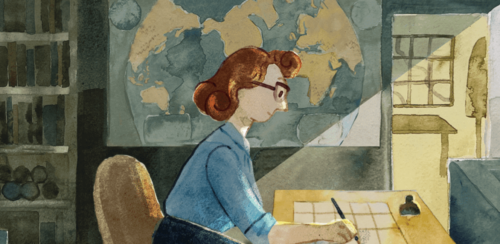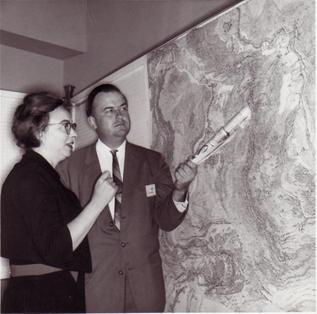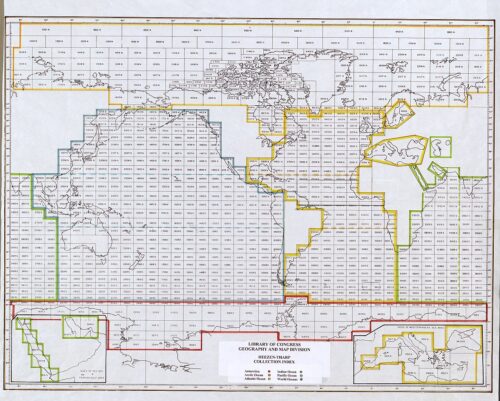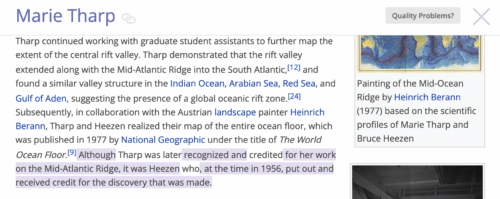When women are exposed to women role models in science, they are more likely to pursue STEM careers and feel a greater sense of belonging in them–a key indicator for career longevity. Reading just one story of a woman in a successful career makes a difference for the confidence and performance of undergraduates in the same field. From this exposure, men too can understand that women thrive with careers in science just as much as men. So imagine 100,000 people reading that same story. What could that do for inequity in STEM at large? You may ask, how could anyone (beyond the rare celebrity scientist) reasonably get that much exposure? Ah, well we have a tale for you.

On November 21, 2022, Google’s Doodle of the day featured Marie Tharp, whose discovery led to the acceptance of continental drift theory. Tharp’s impressive career as an oceanographic cartographer was on full display that day as more than a hundred thousand internet users swarmed to her Wikipedia biography. Thankfully, the biography was robust—touting her contributions to her field and the barriers she overcame as a woman geologist in the ’40s and ’50s. Not all women on Wikipedia are as lucky. Only 19% of the biographies on the site are even about women. When they do have a page, bias mirroring gender inequities in STEM and journalism can creep up in the content. Today, Marie Tharp’s biography is comprehensive and an excellent summary of her contributions to science. But just 6 years ago, it told a very different story.
If you read Tharp’s Wikipedia article in 2017, it might escape you that the Library of Congress considers her one of the four greatest cartographers of the 20th century. The page focused more on the work of her colleague Bruce Heezen than it did on her, painting him as the more experienced scientist, rather than her collaborator. At the time, women weren’t allowed on board research vessels, so Tharp relied on Heezen’s sonar data to create her maps of the seafloor. This earlier version of Tharp’s biography contextualized her discovery of an oceanic rift valley in terms of what Heezen thought about it. He was skeptical, calling her theory “girl talk” and even going so far as to erase her work. Once he was convinced she was right, Heezen took credit for Tharp’s discovery for more than 10 years until her contribution was finally acknowledged. The 2017 version of Tharp’s Wikipedia biography hinted at the injustice, noting that her name was mysteriously missing from publications, but it didn’t explain why. A reader might assume Heezen simply did more of the work.
It was a group effort through Wiki Education’s programs, spanning years, that corrected the narrative.
First, in 2017 an undergraduate student completing a Wikipedia assignment in a Wiki Education-supported course added the barriers that Tharp overcame in pursuing geology, namely that only 4% of all earth sciences doctorates at the time were obtained by women. The student also noted the Library of Congress’ honoring of Tharp’s legacy.

Then, in 2018 a geoscience graduate student trained as a Wiki Scientist came along and detailed how Tharp’s discovery of a rift valley supported the theory of continental drift, which was new and controversial at the time. By adding this point, the Wiki Scientist focused the biography more on Tharp’s findings than on Heezen’s skepticism. They also added the reason Heezen finally came around—a male colleague confirmed Tharp’s work. Perhaps most poignantly, the Wiki Scientist replaced the page’s photograph with one of Tharp herself, rather than one of Heezen “showing” her a map of her own creation.
In 2019, another undergraduate student in a Wiki Education-supported geology course gave more context about Tharp’s map of the ocean floor in the introductory section, adding that it specifically charted the ocean’s topography and multi-dimensional geographical landscape. The student found a preliminary manuscript sketch that Tharp and Heezen made and included that too. The student added an award that Tharp received in 2001 and also updated the section about Tharp’s early life, noting that joining her father in his field work as a soil surveyor sparked her initial interest in cartography. Considering that narratives about women scientists (on Wikipedia and off) are more likely than a man’s to focus on their personal life over their career accomplishments, including the origin of Tharp’s passion for science is a great addition to the information about her upbringing.

Where before, the biography passively mentioned that Tharp’s name wasn’t included in publications of her work, this student made the language more active, noting that it was Heezen who took the credit for Tharp’s discovery in 1956 and that the discovery was not attributed to her for more than a decade. There are plenty of historical instances where discoveries made by women were credited to men at first: from the existence of dark matter to the invention of wireless communication and the first computer language compiler tools. Women scientists are still less likely to be credited for their work than men. Given the persistent barriers women face to being recognized, it’s important to accurately document the contributions from women scientists and Wikipedia is a great place to tell the real story in real time.

When we don’t tell the full story of women scientists’ achievements, we miss the opportunity to positively influence future generations of scientists. Instead, young people may be exposed to pervasive negative stereotypes suggesting that they don’t belong in STEM, which change the way they talk about their dreams and negatively affect confidence and test performance. Sustained over time, this undermining of confidence can lead to women abandoning careers that don’t align with expectations of their gender, race, or class.
We have the chance to change the story–not only for pioneers like Tharp, but for scientists working now. A Wikipedia biography recognizes a scientist’s contributions in real time. It surfaces her expertise to journalists and panel organizers, humanizes her beyond her CV or university profile, and shows young people interested in STEM what career paths are possible for them. Considering women and people of color are chosen less often for speaking opportunities, are contacted less often by journalists, and aren’t recognized for their work in equal measure to white male peers, exposure on Wikipedia can help turn the tides.
We’re proud to see that the work of students and scientists in our programs lives on, and this process worked exactly as Wikipedia was designed to: building upon itself over time as contributors uncovered more of the real story. Together, we’re helping correct the narrative of women’s place in the advancement of STEM, and there’s one thing we know for sure: a woman’s place is in Wikipedia.
